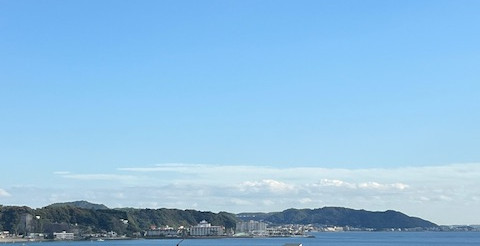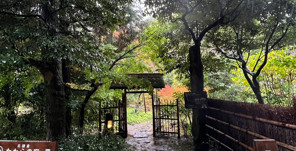横浜の実家に帰省する途次、興味のある深海生物を展示しているとのことなので、新・江ノ島水族館に寄ってみた。小田急線の最寄りの駅で下車すると、構内にクラゲの水槽がある。弥が上にも、気持ちが駆り立てられる。
On the way to my famil home in Yokohama, I stopped by the New Enoshima
Aquarium because I heard that it exhibited the deep-sea creatures which I was very interested in. When I got off at the station on Odakyu Line, I encountered a big tank of jelly fishes in the area. My mind was excited further.
入り口前に、江ノ島の歴史を紹介したブースがある。そこからは、まさにその江の島を眺めることができる。眼前に広がる砂浜は、ゆったりと弧を描いて大磯の方へ続いている。相模湾の伸びやかな海景は、心を穏やかにさせてくれる。
I got the pamphlet of the aquarium at a welcome lounge in the booth and made a rough plan with looking at the map. I predicted that roughly 4 hours would be enough for me to cover the whole area and make a satisfactory observation.
そこに設置されているウェルカムラウンジでパンフレットをいただき、館内図を見て大雑把にプランを立てる。それぞれのエリアの広さから、大体4時間くらいあれば全体を網羅し、納得のいく観察ができるだろうと、予測したのだが、甘かった。
Before the entrance of the aquarium, there was a booth introducing the history of Enoshima. We can see the real Enoshima from it. The beach in front of your eyes continued toward Ohiso in the shape of the loose arc. Your mind would be calm by the spreading seascape of Sagami Bay. I got the pamphlet of the aquarium at a welcome lounge in the booth and made a rough plan with looking at the map. I predicted that roughly 4 hours would be enough for me to cover the whole area and make a satisfactory observation.
But it was foolish.


入り口を入ると、透明生物が出迎えてくれる。
”ミズクラゲ”は、どこでもよく目にする。子供のころにはお盆のころになると砂浜に打ち上げられているのをよく見たし、京都に住んでいたころには福井の漁港で捕獲、観察していたが、昨今は見かけなくなった。海水温の上昇で、生息域に変化が生じたからであろうか。
ウスモモテンジクダイについてであるが、骨まで透けるほど透明な魚は、伊豆半島では見掛けたことはない。やはり、沖縄辺りの南洋に生息しているらしく、浅場に生えている枝状のサンゴ周辺で群生しているそうである。
白い斑点しか見えないようなソリハシコモンエビも、温かい南洋で遭遇できる生物である。動画ではわかりづらいが、赤褐色の斑点もあるらしい。掃除屋さんのホンソメワケベラがいろいろな魚の表面を突いているのはよく目にするが、ソリハシコモンエビも優れたクリーナーであるらしい。クリーナーシュリンプの中では、トップクラスの存在とのことである。
gate.
We often see “Moon Jelly” on almost beaches. During my childhood, I found the jellyfishes washed up on the sandy beaches around the time of Bon Festival
We often see “Moon Jelly” on almost beaches. During my childhood, I found the jellyfishes washed up on the sandy beaches around the time of Bon Festival
when we welcome and send off each dead ancestor. When I had lived in Kyoto, I captured and observed it at the port in Fukui Prefecture. However, I don’t see
them nowadays. I think that their living area may change by the rise in sea
temperature.
As to Zoramia Viridivender, I haven’t seen this kind of transparent fish in Izu
As to Zoramia Viridivender, I haven’t seen this kind of transparent fish in Izu
Peninsula. The school of the fish lives in the branch –like corals growing in the
shallow sea of the Southern Ocean around Okinawa.
Rock Cleaner-Shrimp was too transparent. Therefore, I could see only white
Rock Cleaner-Shrimp was too transparent. Therefore, I could see only white
spots on the surface. It also live in the warm Southern Ocean. It has the red
spots too though it’s hard to tell from the movie. I oftesn see the cleaner,
Bluestreak Cleaner Wasse, which poked the surface of various fish. The shrimp is also the good cleaner. It is one of the best cleaners in the world of the cleaner shrimp.

”相模湾ゾーン”
"Sagami Gulf Zone"

相模湾は、岩場、干潟から深海まで地形が多様なので、生物の種類も豊富である。厳密には、相模湾とは真鶴岬から三浦半島の城ケ島を直線で結んだ部分を言う。深度は1000mを超える。
館内最大規模の水槽では、その相模湾の生態を紹介している。縦にも長いので、海面付近と海底からの2つの情景を楽しむことができる。上層には造波装置が設置されているので、迫力ある波打ち際の様子が実際に再現されている。そこに集まる生物を観察できるのが面白い。
槽内では、約8000匹のイワシも飼育されている。魚群は、奇怪な一つの生き物のようである。サメやエイなどが近づくと、急速に自在に形を変える。眺めていて飽きることがない。
Sagami Bay has the various terrain, for example, rocky area, tidal flats, deep
館内最大規模の水槽では、その相模湾の生態を紹介している。縦にも長いので、海面付近と海底からの2つの情景を楽しむことができる。上層には造波装置が設置されているので、迫力ある波打ち際の様子が実際に再現されている。そこに集まる生物を観察できるのが面白い。
槽内では、約8000匹のイワシも飼育されている。魚群は、奇怪な一つの生き物のようである。サメやエイなどが近づくと、急速に自在に形を変える。眺めていて飽きることがない。
Sagami Bay has the various terrain, for example, rocky area, tidal flats, deep
sea and so on. So, there is a rich variety of living creatures. Strictly speaking,
Sagami Bay is the part inside a straight line from Cape Manazuru to Jogashima on the Miura Peninsula. The depth is over 1000m.
In the biggest tank of the aquarium, the ecology of Sagami Bay was introduced. As the tank has depth, we can enjoy watching two scenes, near the sea surface and the seafloor. The wave-making equipment is installed at the upper level of
In the biggest tank of the aquarium, the ecology of Sagami Bay was introduced. As the tank has depth, we can enjoy watching two scenes, near the sea surface and the seafloor. The wave-making equipment is installed at the upper level of
the tank. So, the dynamic scene of the water breaking was actually recreated.
It’s exciting that we can observe the creatures gathering in the place.
About 8000 sardines were also kept in the tank. The school looked like one
About 8000 sardines were also kept in the tank. The school looked like one
strange creature. When sharks or rays approached, it changed the shape
rapidly and freely. I never got tired of looking at it.
シラスサイエンスのエリア
"The Area of Whitebait Fish"

おそらく皆さんも大好きであろう御飯のお供、シラス。湘南・江ノ島の特産であるらしい。そのシラスの、孵化後間もない姿から成魚のカタクチイワシになるまでの成長過程を、実物で段階的に紹介してくれている。2013年の繁殖の成功から順次代を重ねているものの、生態についてはまだ謎が多く、飼育しながら試行錯誤を繰り返しているようである。その熱く真っ直ぐな探求心には、頭が下がる思いである。
Whitebait, which probably you like very much as a side dish for rice! I heard that it is a specialty product of Shonan, Enoshima. Here introduced us the growing
Whitebait, which probably you like very much as a side dish for rice! I heard that it is a specialty product of Shonan, Enoshima. Here introduced us the growing
process from appearance shortly after hatching to adult anchovy step-by-step
with the real. Since the successful breeding in 2013, successive generations
have been produced. But there are still many mysteries about its ecology. Trial and error are repeated while keeping it. I am deeply impressed with their
passionate and serious spirits of inquiry.
太平洋ゾーン
"Pacific Oxean Zone"

相模湾の外洋では、寒流の親潮と暖流の黒潮が衝突している。そのためここでは、季節によっては北に生息する地味な色合いでありつつ衝撃的な容姿の魚類も、南洋の生き生きとしたカラフルな魚類も、両方を観察できる。
眉間に皺を寄せているどころではない。顔中に皺を寄せて、血管まで浮きだたせているようなオオカミウオは、表情こそ怖いものの、寄り添っているのが却って微笑ましい。
それとは対照的なのが、フウセンウオである。張り付いて動かないやる気のなさと、ハコフグのような稚拙な泳ぎ方は、皆の心を虜にし、癒やされることは間違いないであろう。その割には肉食で、エビやカニなどを捕食しているそうである。
In the open sea of Sagami Bay, the cold Oyashio Current and the warm
眉間に皺を寄せているどころではない。顔中に皺を寄せて、血管まで浮きだたせているようなオオカミウオは、表情こそ怖いものの、寄り添っているのが却って微笑ましい。
それとは対照的なのが、フウセンウオである。張り付いて動かないやる気のなさと、ハコフグのような稚拙な泳ぎ方は、皆の心を虜にし、癒やされることは間違いないであろう。その割には肉食で、エビやカニなどを捕食しているそうである。
In the open sea of Sagami Bay, the cold Oyashio Current and the warm
Kuroshio Current collide. Therefore, we can watch the plain-colored but
shocking-looking fish that live in the Northern Ocean, and the vivid and colorful
fish of the Southern Ocean.
The fishes, “Wolffish” didn’t wrinkle only their eyebrows. They wrinkled all the
The fishes, “Wolffish” didn’t wrinkle only their eyebrows. They wrinkled all the
faces and even the veins were visible. Though the expression on their faces
were scary, it’s quite haeartwarming that they were so close to each other.
Balloon Lumpfish was In contrast to them.We can feel lack of its motivation by
Balloon Lumpfish was In contrast to them.We can feel lack of its motivation by
the clinging and unmoving shape and would be definitely healed by a clumsy
swimming style like a boxfish. Despite the loose style, they are carnivorous and
prey on shrimp and crabs.
二本筋のクマノミは伊豆でも観察できるが、カラフルな三本筋のカクレクマノミはやはり温かい海洋特有の生物であろう。水槽ではその後方に、一本筋のハマクマノミも観察できる。
We can watch two-stripe clownfish. But colorful three-stripe clownfish is
probably a creature unique to warm oceans. In the tank, single-stripe clownfish swam behind the three-stripe clownfish.















